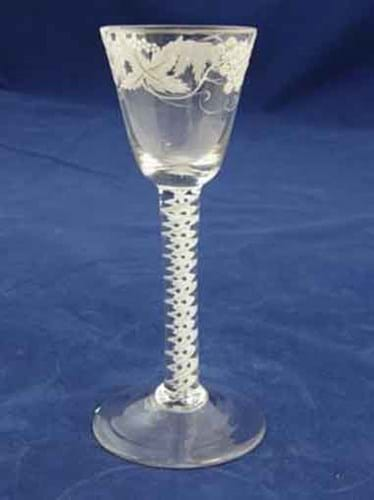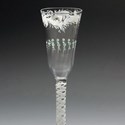The Beilby family of Newcastle: William, Richard and Mary were all skilled glass decorators who learned how to fire enamels onto glass and worked for different factories in the Newcastle area.
Their decorative repertoire ranged across various categories from simple white enamel floral or avian motifs, painted around the bowl of small cylindrical bowled wine or cordial glasses, via more complex classical architectural vignettes to armorials in polychrome enamels.

A 6¼in (16cm) high Beilby wine glass with a bell bowl enamelled with vines set on a multiple opaque twist stem. From the Peter Barry collection - £1000 at Ewbanks, March 2011.
Their most complex works were the large glasses and decanters made as special commissions for particular families or events such a ship launch.
In terms of identification, a handful of pieces are signed but most are attributed to the Beilbys on account of their style or quality. While virtually all enamelled glassware of this type from this period tends to be given a Beilby or Beilby-type attribution, it seems unlikely that there were not other talented decorators of the period who produced what was obviously a sought-after form of painted drinking glass.
The James Giles workshop in London, another often-cited attribution also produced enamelled glassware and there are doubtless other workshops whose work is characterised as "Beilby type" or "Beilby style" yet to be brought to full prominence.
What Do People Collect?
For reasons of relative scarcity and the market shifts outlined below, no Beilby glass can really be described as cheap.
Indeed, there is probably not enough Beilby glass out there for enthusiasts to confine their collecting to this alone. Most collectors are likely to have one or two glasses as part of a larger drinking glass collection.
However, one or two particularly keen collectors like Chris Crabtree and A.C. Hubbard built up larger holdings that covered the entire output of styles and forms, ensembles whose existence we know about because they have come back to market for resale.
Entry-level buyers in this market will struggle to find much in the three-figure bracket although mid-18th century enamelled wine glasses featuring the types of motifs detailed above that are described as 'Beilby type' are the most affordable.

The classic standard Beilby drinking glass, enamelled around the bowl with a border of fruiting vine leaves, 5½in (14cm) high, set on an opaque twist stem. Sold for £1200 at Mellors and Kirk in July 2004.
Drinking glasses make up the bulk of the Beilby output. The most affordable glasses are simply decorated mid 18th century wine glasses often set on an opaque twist stem and standing around 6-7in (16-18cm) high. These are the most readily available and there is repertory of motifs that are frequently repeated, most commonly fruiting vines or formal neo-classical swags around the rim of the bowl.
These tend to be priced in the £1000-£3000 depending largely on the amount of decoration.
More complex are the landscape vignettes often incorporating architectural motifs and figures which are often derived from stock print sources like The Ladies Amusement which were also used for decoration on porcelain of the same period. Here the price bracket moves up from around £2000-10,000.
As in every other field, established collectors want documentary pieces that have a provenance so glasses whose decoration features an armorial or inscription often set in rococo cartouches are the most highly regarded. Just under 100 armorial goblets are known to have survived, 16 of them signed.
It is a case in point that for the rarest pieces even a substantial amount of damage or restoration is tolerated in the way that it would not with a generic glass of the same period. The polychromed goblet made for the Beilby-Thompson family of Micklethwaite Grange, for example, which had lost its foot made £13,000 in 2006 and following restoration increased that price to £32,000 when it was auctioned four years later.
The Market
The performance of specialist fields like Beilby has diverged dramatically from the more consistent general performance of the market for 18th century drinking glasses.

A 6in (15cm) Beilby wine glass of c.1765, enamelled to the round funnel bowl with a band of fruiting vine, set on a double series opaque-twist stem and a conical foot – £1650 at Dreweatts, October 2003.
Beilby prices have on the whole been on an upward trajectory for several decades.
Readily available scholarship can often increase interest and demand and the publication of James Rush's book The Ingenious Beilbys in 1973 introduced this glassware to a much wider audience in this country and the US, helping values to climb.
Prices took a few dramatic leaps forward around the turn of the 21st century as collectors like Crabtree and Hubbard competed to build up their collections, producing a string of unprecedented auction highs.
A few years later, however, both these collectors turned vendor unleashing quantities of top-dollar Beilby glass on the market. The collecting air is always thinner at the top of the tree so with supply outstripping demand, prices stagnated or even fell back a little.
As in all fields, provenance and rarity still hold sway and if one of the handful of signed special commissions come up these market factors might still be over-ridden.
Values therefore have not fallen back to pre-1990s levels and Beilby glass still performs well above pieces of equivalent date or form without this distinctive decoration.
Further Reading
The Ingenious Beilbys by James Rush, Barrie & Jenkins (1973), ISBN-13: 978-0214654121
The decorated glasses of William and Mary Beilby 1761-78 by James Rush, Laing Art Gallery (Newcastle, 1980), ASIN: B004FO7I66
William Beilby and the Art of Glass by Simon Cottle, The Glass Circle Journal 9 (2001), p31-40

A 6in (15cm) high Beilby type wine glass of c.1770 enamelled to the funnel bowl with foliate swags set on a double series opaque twist stem and conical foot – £800 at Dreweatts, March 2011.


























